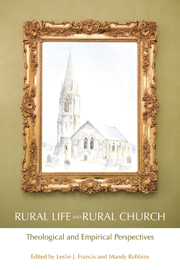Book contents
- Frontmatter
- Contents
- Preface
- Foreword by The Bishop of Shrewsbury, The Rt Revd Mark Rylands
- 1 Introduction: shaping rural theology
- PART 1 PERSPECTIVES FROM THE BIBLE
- PART 2 PERSPECTIVES FROM ORDINARY THEOLOGY
- PART 3 THEOLOGICAL AND SOCIOLOGICAL PERSPECTIVES
- PART 4 HISTORICAL PERSPECTIVES
- PART 5 LISTENING TO VISITORS
- PART 6 LISTENING TO THE COMMUNITY
- PART 7 LISTENING TO CHURCHGOERS
- PART 8 LISTENING TO CHURCH LEADERS
- 24 Deployment of the churches' ministry: Anglicans and Methodists in a rural diocese
- 25 Views on baptism and confirmation in the Church in Wales: are rural clergy different?
- 26 Children and communion: listening to churchwardens in rural and urban Wales
- PART 9 SATISFACTION AND STRESS IN MINISTRY
- Contributors
- Sources
- Subject Index
- Name Index
24 - Deployment of the churches' ministry: Anglicans and Methodists in a rural diocese
from PART 8 - LISTENING TO CHURCH LEADERS
- Frontmatter
- Contents
- Preface
- Foreword by The Bishop of Shrewsbury, The Rt Revd Mark Rylands
- 1 Introduction: shaping rural theology
- PART 1 PERSPECTIVES FROM THE BIBLE
- PART 2 PERSPECTIVES FROM ORDINARY THEOLOGY
- PART 3 THEOLOGICAL AND SOCIOLOGICAL PERSPECTIVES
- PART 4 HISTORICAL PERSPECTIVES
- PART 5 LISTENING TO VISITORS
- PART 6 LISTENING TO THE COMMUNITY
- PART 7 LISTENING TO CHURCHGOERS
- PART 8 LISTENING TO CHURCH LEADERS
- 24 Deployment of the churches' ministry: Anglicans and Methodists in a rural diocese
- 25 Views on baptism and confirmation in the Church in Wales: are rural clergy different?
- 26 Children and communion: listening to churchwardens in rural and urban Wales
- PART 9 SATISFACTION AND STRESS IN MINISTRY
- Contributors
- Sources
- Subject Index
- Name Index
Summary
Abstract – Changes within society in recent years have created difficulties of various kinds for churches in England. Both the Church of England and the Methodist Church in Great Britain have found difficulty in staffing their churches as once they did. A survey of all the clergy in pastoral appointments in the Diocese of York and all similarly employed ministers in the York and Hull Methodist District seeks to document the differences in practice and contrasting provision of ministry to rural churches offered by these two denominations.
Introduction
Both Anglicans and Methodists tend to look back on their pasts with a certain nostalgia. For the Anglicans it was a time when each village or centre of population in the country had at its heart a parish church staffed by a clergyman whose duty it was to have the cure of souls for all those who lived within the parish boundary. This past has been well documented by Anthony Russell in The Clerical Profession (Russell, 1980) and The Country Parish (Russell, 1986). One element of nostalgia for Methodists in the countryside is when chapel and church existed side by side in the village, often perhaps in terms of social rivalry, and later in coexistence. Robert Moore's Pitmen, Preachers, and Politics (Moore, 1974), David Clark's Between Pulpit and Pew: folk religion in a North Yorkshire fishing village (Clark, 1982), and Clarke and Anderson's Methodism in the Countryside: the Horncastle Circuit, 1786–1986, (Clarke and Anderson, 1986) illustrate the situation of the Methodist chapel in County Durham, the East Yorkshire coast and Lincolnshire.
- Type
- Chapter
- Information
- Rural Life and Rural ChurchTheological and Empirical Perspectives, pp. 286 - 298Publisher: Acumen PublishingPrint publication year: 2012

